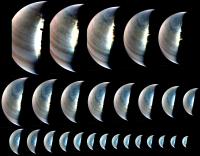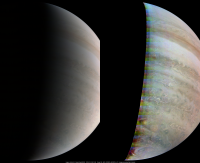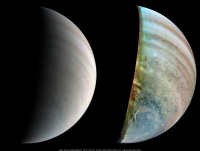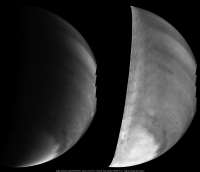Printable Version of Topic
Click here to view this topic in its original format
Unmanned Spaceflight.com _ Juno _ Juno Perijove 48
Posted by: mcaplinger Jan 28 2023, 04:48 PM
https://www.nasa.gov/feature/jpl/nasa-s-juno-team-assessing-camera-after-48th-flyby-of-jupiter
However, on this new occasion the issue persisted for a longer period of time (23 hours compared to 36 minutes during the December close pass), leaving the first 214 JunoCam images planned for the flyby unusable. As with the previous occurrence, once the anomaly that caused the temperature rise cleared, the camera returned to normal operation and the remaining 44 images were of good quality and usable.
The good images have been posted to missionjuno.
Posted by: mcaplinger Jan 29 2023, 03:54 AM
To correct some misimpressions I have heard in various channels:
The Junocam instrument paper says that
provide temperature knowledge for radiometric calibration.
Since PDS release 8, the focal plane temperature is given in the metadata for each image. It is not correct (always says 0C) in earlier releases and in the missionjuno metadata for regrettable but unintentional software bookkeeping reasons.
I wish I could describe our ongoing diagnostic efforts in more detail, but I can't for various reasons that those of us who have worked on these missions are all too aware of.
Posted by: Antdoghalo Jan 29 2023, 06:33 AM
Sorry your awesome camera is having problems, It has been a real trooper given what it was meant for and what its going through. Io torus is not friendly to spacecraft!
Posted by: Gerald Jan 29 2023, 06:27 PM
Could you please release at least one of the invalid raw images, if they aren't completely saturated by noise?
I'd like to see whether thermal noise can be filtered out or smoothed to a level where meaningful image data can be extracted.
A private access would be ok, if a public release appears inappropriate.
Of cours only when you have time.
Posted by: mcaplinger Jan 29 2023, 10:18 PM
Everyone should stop assuming that somehow this is a choice I can make, it's above my pay grade.
If the images showed anything useful in terms of scene content, we would have pushed harder to get them released.
Posted by: vjkane Jan 29 2023, 10:42 PM
There are good engineers working the issue(s). I wish them the best, and with their skills and luck, we will have a functioning camera for the close Io encounters.
Whatever happens, wow! for all the great images so far, and many thanks to those who have processed them for our enjoyment.
Posted by: Gerald Jan 29 2023, 11:47 PM
Thanks a lot, Mike!
You might imagine that I happen to get similar questions via email.
Here are PJ48 drafts:
http://junocam.pictures/gerald/uploads/20230128/index.html
I'll upload other processed versions here over the next few days:
http://junocam.pictures/gerald/uploads/uploads_by_pj.html#PJ48
Some copies will also be submitted to the missionjuno site.
Posted by: StargazeInWonder Jan 30 2023, 12:46 AM
It's an understatement to say that JunoCam has become one of those systems that has significantly outlived the design requirements, whether you measure by years or orbits. It's been great so far and if we get a few images of the closer Io encounters, that will be fantastic.
Posted by: Decepticon Jan 30 2023, 02:47 AM
Wait the imager has totally failed? Or did it fault?
Posted by: Brian Swift Jan 30 2023, 04:58 AM
PJ48 Reduced Resolution Exaggerated Color/Contrast Collage
Posted by: volcanopele Jan 30 2023, 02:38 PM
Glad to see that the camera overall is still okay, so there is hope! I just want you to know Mike how great the images have been from JunoCAM and how useful the Io images have been so far, yes even at 44 km/pixel. Really pulling for you all to come up with a solution or workaround for this issue.
Posted by: stevesliva Jan 30 2023, 04:44 PM
The tape got stuck during part of the flyby. /joke
Sounds like there is a mode where the camera is alive and recording images, but they're noise. Reasons not entirely explained yet. And it relates to how long it's been active with "how long" having large error bars. But the camera has eventually come around and taken images in all cases. AFAICT.
Posted by: Gerald Jan 30 2023, 08:29 PM
Here is PJ48, image #216, roughly illumination-adjusted, and gamma-stretched, I think to the 2nd power of radiometrically linear (gamma=4 wrt. square-root encoding)
I've used linear radiometric weights derived from PJ47. Usually, using the weights of the preceding PJ is ok. But this time the reddening seems to be significantly stronger. This suggests that the camera experienced a higher radiation dose than for previous PJs. I'm going to quantify this more accurately, before I'll perform a second run with updated weights.
But overall, the CCD sensor is looking fine. Just the optics appears to be darkening faster than it used to do so before.
Posted by: Bjorn Jonsson Jan 31 2023, 12:07 AM
This is very interesting - I may have noticed hints of this already in the PJ47 images. The change was probably not as fast back then as it appears to be now though but I haven't analyzed this in any detail yet. I noticed *lots* of radiation noise in some of the PJ47 southern hemisphere images and this might be of significance. From http://www.unmannedspaceflight.com/index.php?s=&showtopic=8742&view=findpost&p=259607:
It now occurs to me that maybe I should have used different color correction for the PJ47 northern hemisphere images than I used for the southern hemisphere images. I remember I was slightly surprised by the bluish color of a PJ47 northern hemisphere image. The high northern latitudes are more blue than areas closer to the equator but despite this I was a bit surprised. I now think that by using the southern hemisphere images to determine the correction I may have 'overcompensated' for the image reddening when processing the northern hemisphere images. I may take a look at this soon since it is clear that I will be spending less time processing PJ48 images than I was expecting.
Posted by: Gerald Jan 31 2023, 01:39 AM
In the meanwhile, I've done some quantitative analysis.
The below PDF contains relative white-balancing linear radiometric factors for Jupiter from PJ43 to PJ48 for r(ed), g(reen), b(lue), together with the quotients PJ n / PJ n-1 for red (quot_r) and blue (quot_b), and quot_r/quot_b for the factor by which the white-balancing linear radiometric factors for the red and blue channel change from one PJ to the next, in the last column quot_br.
Added are plots of time series of columns r, b, and quot_br. wb_weights.pdf ( 34.21K )
: 98
wb_weights.pdf ( 34.21K )
: 98
I've actually used RGB images with the most frequent TDI setting within the respective PJ for the calibration. Except for PJ48, I removed images with eclipses, or when the GRS was prominent.
This animated GIF visualized the empirically retrieved reddening from PJ47 to PJ48:
You may be right, Björn, that the radiometric factors could change between inbound and outbound images. Juno is indeed crossing some harsh radiation belts.
However, I didn't yet try to find regression curves for the radiometric factors within a PJ.
Posted by: StargazeInWonder Jan 31 2023, 04:41 AM
Responding to some of the implications of the past couple of posts: As I look at diagrams of how Juno's orbit has evolved, it looks as though the greatest radiation exposure is mainly occurring during a time in each orbit before any of the close Jupiter approaches / imagery. I.e., Juno arrives from the south, crosses Jupiter's equatorial plane and the intense radiation belt between Io and Europa while still quite far from Jupiter, and then is in (presumably?) lower radiation environments for the duration of the perijove. So, for whatever it's worth, I'd expect comparatively little radiation exposure between the northern/inbound imagery and the southern/outbound imagery.
It's also a bit ominous to see how much more time Juno will spend passing through the most intense radiation between now and the first close Io flyby, compared to how much it has spent taking radiation so far. Hopefully any operational issues don't increase in proportion to that.
Posted by: Gerald Jan 31 2023, 05:22 PM
Juno's very eccentrical orbit was designed to minimize radiation dose, by quickly crossing the belts of high energetic particle flux and then diving underneath that hazard. But it was also well-known that the perijove shifting northward would increase radiation after about PJ30.
I think that it wasn't known that there is also https://www.jpl.nasa.gov/images/pia22179-new-radiation-zones-on-jupiter.
Posted by: mcaplinger Jan 31 2023, 06:05 PM
I don't think he was saying that, I think he was saying that Jupiter is a different color between hemispheres. But even if he wasn't saying that, you can't prove otherwise.
Not to complain, but when people here say stuff about radiation changes, someone from the project stumbles across it, and I end up having to do more work to try to quantify it. So far I haven't found unequivocal evidence that there have been intrinsic instrument changes. You could do me a favor by being as specific as possible about what you are doing, which images and which regions of which images, attempts to control for photometric effects if any, etc. Then I can just paste that into my slides, and I'll be happy to give you all the credit.
Posted by: Bjorn Jonsson Feb 1 2023, 01:35 AM
Gerald understood correctly what I was saying. However, the real color of the southern hemisphere also isn't identical to the real color of the northern hemisphere and this complicates matters. Also it is getting increasingly difficult to reliably monitor color changes because many of the images now show dimly lit areas near the terminator. This can make possible scattered light, dark current and noise a bigger proportion of the image brightness and this might mess up the color. My main (but not only) 'color reference' has been the whitish South Tropical Zone (STrZ). Getting good color measurements for the STrZ has been getting increasingly difficult due to the increasing phase angle. It is 95° in image PJ48_215, meaning that the STrZ is relatively dimly lit except near the limb. This makes me less confident in the color measurements than I was a few perijoves ago. Nevertheless I think something must have changed now. Using the color correction I used for PJ47, the color of image PJ48_215 is far too red. It is far redder than the color of comparable images at PJ47 or PJ46 when I used the color correction from the previous perijove.
The problem: I'm (almost) sure something has changed significantly at PJ48 compared to PJ47 but I doubt I can prove it (or, in particular, doubt I can prove that it is an instrument change). This "something" that apparently has changed could be e.g. optics, scattered light, filters, sensor or a combination of these.
Posted by: Gerald Feb 1 2023, 02:07 AM
Give me a day or so to compile all the underlying data I've more or less readily available. I'll mail you a download link with a cc to at least two other members of the Juno science team. We've already discussed this topic in person before. I'm ready to take over whatever extra work load is required to the degree I'm authorized.
Posted by: StargazeInWonder Feb 1 2023, 02:49 AM
Bjorn, can the imagery of Ganymede taken during this orbit provide insight as to any possible changes? I know that that's not quite as good as the color calibration devices on Mars landers/rovers but perhaps it offers some apples-to-apples comparisons with past imagery?
Posted by: Brian Swift Feb 1 2023, 07:34 AM
FWIW, mapping my (less rigorous) color balance updates to Gerald's G=1 scaling
PJ24 {0.844983, 1., 2.32047}
PJ37 {0.773423, 1., 2.42996}
PJ43 {0.739846, 1., 2.66805}
PJ48 {0.64491, 1., 2.99845}
Posted by: Bjorn Jonsson Feb 5 2023, 01:41 AM
Image PJ48_215 in approximately true color/contrast and enhanced versions. North is up.
No, Ganymede is far too small in the PJ48 image.
Posted by: Bjorn Jonsson Feb 10 2023, 12:28 AM
This is image PJ48_218, a methane filter image:
The version at left is the image with no special processing. The version at right is illumination-adjusted. Both of these versions were processed to reduce noise since the methane filter images are usually noisy. North is up.
Posted by: Bjorn Jonsson Feb 11 2023, 11:51 PM
I should mention that interestingly, I have found that if I use any of the most recent clock kernels (JNO_SCLKSCET.00144.tsc, 143 or 142) I get very large pointing (or timing?) errors, typically ~230 (!) pixels in the vertical direction in the images. I have to use JNO_SCLKSCET.00141.tsc to get normal results. I find this interesting because JNO_SCLKSCET.00141 predates PJ48. In fact JNO_SCLKSCET.00142 and 143 also predate PJ48.
The same is true for PJ47, I get large errors unless I use JNO_SCLKSCET.00141.tsc (I suspect 140 would also work). JNO_SCLKSCET.00141.tsc predates not only PJ48, it also predates PJ47.
Posted by: Brian Swift Feb 17 2023, 06:58 AM
The same is true for PJ47, I get large errors unless I use JNO_SCLKSCET.00141.tsc (I suspect 140 would also work). JNO_SCLKSCET.00141.tsc predates not only PJ48, it also predates PJ47.
Thanks. Investigating this made me realize I'd processed PJ48 using the PJ47 SPK predict.
After reprocessing PJ48 using today's juno_pred_orbit.bsp and JNO_SCLKSCET.00145.tsc,
the largest offsets I'm seeing are ~9 pixels. But even using PJ47 predict and 144.tsc, I was only seeing offsets of ~15 pixels.
Below is PJ48_217, one of the large offset images, with limbs marked.
I'm curious if "mis-fit" on right will get better when PJ48 reconstructed SPK shows up.
Powered by Invision Power Board (http://www.invisionboard.com)
© Invision Power Services (http://www.invisionpower.com)








